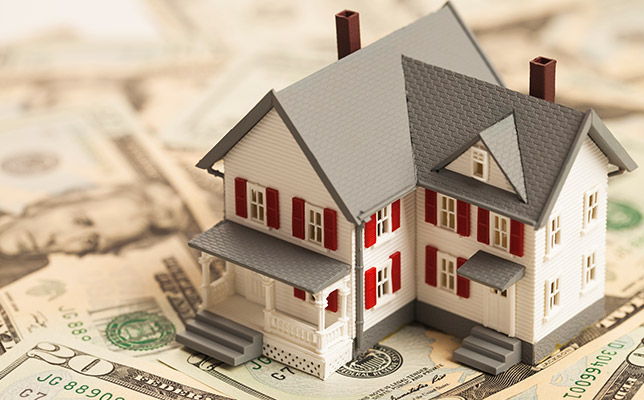Turning Your Home Equity Into Ready Cash
The ease with which homeowners can borrow against their home equity makes it tempting, but when and how to do so?

The ease with which homeowners can borrow against their home equity makes it tempting to do so, whether to pay for a home remodeling project, cover an unexpected significant expense, or pay off higher-interest debt. But take a clear-eyed look at whether borrowing against your house would be wise.
It may seem perfectly reasonable to finance a remodeling project by borrowing against your home, especially if the interest charged is tax-deductible. (Under current law, interest on a home equity loan is deductible only if the loan is used for home improvements.) However, it may be wiser to put off the project and save for it in advance.As for debt consolidation, swapping high-interest credit-card debt for cheaper home-equity debt seems like a no-brainer. But if you haven’t addressed the cause of your credit card debt (such as overspending), paying it off with another type of debt likely will be no more than a temporary fix.
Keep in mind, too, that trading unsecured credit card debt for a debt collateralized by your home increases your risk. Not paying on a credit card in a timely fashion will harm your credit score, but failing to pay a home equity loan could result in foreclosure and the loss of your home.
With those necessary cautions in mind, we’ll now discuss three ways to borrow against your home equity: (1) a home-equity loan, (2) a home-equity line of credit (HELOC), and (3) a cash-out refinance. (Homeowners age 62 or older may also have the option of a “reverse mortgage.”)Both home equity loans and HELOCs involve borrowing against the money you’ve already paid on your mortgage and any increase in value that has occurred since you purchased the property. For example, let’s assume that you still owe $100,000 on a house you bought some years ago for $200,000. The property has since increased in value to $300,000. That means your equity in the home is $200,000 — the current value of $300,000 minus the $100,000 still owed.
To qualify, you generally must have an equity position equal to at least 20% of your home’s value. In addition, the lender will calculate your “loan-to-value ratio” — i.e., how much you will owe (mortgage plus equity loan or HELOC) in relation to the appraised value of the property. Most lenders insist on loan-to-value ratios that are no more than 85%-90% of a property’s value. So, if your property was valued at $300,000, a lender likely wouldn’t approve an equity loan or HELOC that would put your overall house-related debt higher than $255,000-$270,000.
Before approving a loan, a lender also will check your credit history and gauge whether your overall debt seems manageable as a percentage of your income.
1.Home Equity LoanThe terms for this type of loan are similar to those for a conventional fixed-rate mortgage (a home equity loan is sometimes called a “second mortgage”). The homeowner receives the borrowed money in a lump sum and pays it back in regular, equal payments over a specified term — usually 5–15 years.
Because your property serves as collateral, and therefore the bank is taking less risk, rates on home equity loans tend to be lower than for unsecured “personal” loans. Right now, home equity loan rates are in the 5%–6% range
Typically, closing costs amount to 2%–5% of the loan value, although a lender may offer a “no-closing-cost” option. In the latter case, be sure to ask if the loan is really free of such costs or if the lender is rolling those costs into the loan balance (or possibly charging a higher interest rate instead of closing costs).
2.Home-Equity Line of CreditUnlike a home equity loan, a HELOC doesn’t provide a single lump sum. Instead, the homeowner gains access to a “line of credit” that enables borrowing via an account-related credit card or check. But read the fine print. Some HELOCs require the borrower to take a “minimum initial advance” (typically $10,000–$25,000) when the credit line is approved, meaning interest on that initial amount will start accruing right away.
HELOCs usually carry a variable rate equal to 2% plus the prime interest rate (the prevailing rate banks charge their best customers). That means that when the prime rate rises (or falls), a HELOC rate will move in tandem. At present, HELOCs are in the 3%-4% range. As with a credit card, you’ll be charged interest only on the amount you borrow, not on the total limit for which you’ve been approved.
Most HELOCs are structured with a “draw” period and a “repayment” period. The draw period, usually lasting 5–10 years, is when you can access the line of credit. The repayment period is just what it sounds like: the time when you must repay the borrowed money. A typical HELOC might have a draw period of 10 years and a repayment period of 20 years.
Many lenders offer the option of making interest-only payments during the draw period, then switching to interest-plus-principal payments during the repayment period. That may sound like an attractive proposition, but paying “interest only” means repaying a HELOC will take a long time — and increase your cost. Also, the eventual changeover to interest-plus-principal payments during the repayment period will mean sharply higher monthly payments. (Some HELOCs can be converted to a fixed-rate equity loan during the repayment period.)
Even though HELOCs don’t require a formal closing, and typically the fees are lower than those tied to home equity loans, there may be “origination” or application fees. Also, be prepared to pay an annual “maintenance” fee of $50-$100, even during periods when you don’t borrow any money.
3.A “Cash-Out” Refinance Instead of choosing a home equity loan or a HELOC, you could tap the equity in your house by refinancing your mortgage based on the appreciated value of your property and receiving part of the proceeds as cash. In other words, the new loan would pay off your original mortgage and supply cash (for whatever purpose you may have). Other considerationsHome equity loans are a good option for one-time expenses, such as a home improvement project, a wedding, or a specific healthcare need. In contrast, a HELOC can be helpful if you’re unsure how much you may need to borrow over a particular period. Further, a line of credit can serve as a “backup emergency fund” to help a homeowner ride out a financial reversal.
As you weigh the pros and cons, consider the current interest-rate environment. We are entering a period of rising rates, meaning variable rates on HELOCs likely will increase in the months ahead. Depending on your particular needs, the rate trend may make a fixed-rate equity loan more attractive than a variable-rate line of credit.
It’s also important to consider the rate environment if you plan to do a cash-out refinance. With rates starting to rise, locking in a fixed rate may be preferable to taking your chances with an adjustable-rate mortgage.
Here are other things to keep in mind if you’re thinking about a cash-out re-fi. Generally speaking, refinancing your house and taking cash out is preferable to an equity loan/HELOC only if: (1) current rates are below what you’re paying now, (2) you want to take out a large sum (such as more than $100,000) and use it for something other than home improvement, or (3) you need longer repayment terms than are available with a home equity loan or HELOC.
A word of warning: Never lose sight of the fact that home values can fall as well as rise. As home prices have risen sharply over the past couple of years, many homeowners have seen rapid equity growth. But if prices were to collapse, such as occurred in 2008, having too much house-related debt could put you in the position of being “upside-down” — i.e., owing more on the loans secured by your home than your property is worth. If you had to sell while prices were down, you could incur severe damage to your financial health.
Crunch the numbersRates and closing costs vary for all three of the “tap your equity” options mentioned above, so shop around. Be sure to ask about any other fees that may apply. For example, some home equity loans and HELOCs will charge a fee if you repay the loan or close the line of credit too soon (from the lender’s point of view). As you weigh your options, it may be helpful to create a spreadsheet showing the fees, interest rate, term, monthly payment, and total payment.
One more thing. If you choose to tap your home equity, SMI’s standard mortgage-related advice applies: Keep the total of your first and second mortgage, interest, and taxes to no more than 25% of your monthly gross income — preferably no more than 20%. And plan to have all such debt paid off as quickly as possible — certainly no later than when you retire.
Related Articles

May 21, 2025
The Danger of Buy Now, Pay Later

May 18, 2025
The Hidden Danger of Buy Now, Pay Later
In a culture of instant gratification, it's easier than ever to get what we want, even if we can't afford it....

March 2, 2025
What is good debt vs. bad debt?
Is all debt bad? Or does some good debt exist? Here are the biblical principles to discern the difference....